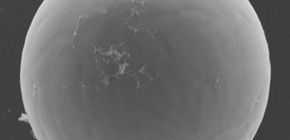
Fabrication of anisotropic single-crystalline microspheres, a world first
This group succeeded in fabricating anisotropic single-crystalline microspheres as large as 1 µm in size
A group of researchers* from Osaka University and Osaka Prefecture University succeeded in fabricating anisotropic single-crystalline microspheres through the use of superfluid helium.
*
• Graduate School of Engineering Science, Osaka University -- OKAMOTO Shinya (then student in the second-term of a doctoral program), INABA Kazuhiro (then a student in the second-term of a doctoral program), ASHIDA Masaaki , Professor
• Institute for NanoScience Design, Osaka University -- ICHIKAWA Satoshi , Specially Appointed Associate Professor
• Osaka Prefecture University -- IDA Takuya , Associate Professor, ISHIHARA Hajime , Professor
Usually single crystals take a form reflecting their atomic arrangement such as cuboid or hexagonal prism. This group succeeded in fabricating anisotropic single-crystalline microspheres, microspheres large enough to be observed with an optical microscope, a world first. Heretofore, it has been possible to fabricate nano-size single crystals; however, when researchers have tried to make bigger crystal spheres, the crystals themselves grew as they liked, resulting in polycrystalline states or amorphous shapes. Thus, micron-size single-crystalline sphericity appeared only possible in messy arrangements. While, in theory, crystals have the potential to become high-performance optical resonators, a foremost condition is that high sphericity must be achieved in their generation.
This group succeeded in fabricating anisotropic single-crystalline microspheres from a variety of materials by using laser ablation in superfluid helium. By making use of this technology with materials such as ZnO, CdSe, and ZnS, this group succeeded in fabricating anisotropic single-crystalline microspheres as large as 1 µm in size. The technology developed by this group for creating single-crystalline microspheres most likely lends itself to fabrication of such from a wide variety of elements.
As a non-linear optical device, single-crystalline microspheres can have significantly better properties than those of conventional materials. In addition to their sphericity, the surface of single-crystalline microspheres is smooth at the atomic level; therefore, they have less resistance. Thanks to such properties, single-crystalline microspheres will be used for a variety of fields other than optical science, in fields such as for drug delivery, in transporting pharmaceuticals in the body.
Abstract
Microspheres with high sphericity exhibit unique functionalities. In particular, their high symmetry makes them excellent omnidirectional optical resonators. As such perfect micrometre-sized spheres are known to be formed by surface tension, melt cooling is a popular method for fabricating microspheres. However, it is extremely difficult to produce crystalline microspheres using this method because their surfaces are normally faceted. Only microspheres of polymers, glass, or ceramics have been available, while single-crystalline microspheres, which should be useful in optical applications, have been awaiting successful production. Here we report the fabrication of single-crystalline semiconductor microspheres that have surfaces with atomic-level smoothness. These microspheres were formed by performing laser ablation in superfluid helium to create and moderately cool a melt of the anisotropic semiconductor material. This novel method provides cooling conditions that are exceptionally suited for the fabrication of single-crystalline microspheres. This finding opens a pathway for studying the hidden mechanism of anisotropy-free crystal growth and its applications.

Figure 1

Figure 2

Figure 3
To learn more about this research, please read the full research report entitled " Fabrication of single-crystalline microspheres with high sphericity from anisotropic materials " at this page of the Scientific Reports website.
Related link :
